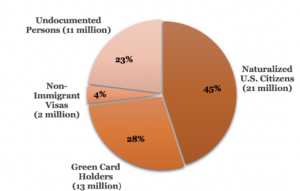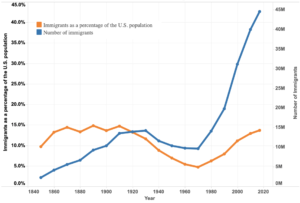Immigration has long been a crucial part of the American story, but the U.S. immigration system has become increasingly outdated, complicated, and difficult to understand. What follows is a primer that should begin to clarify what is going on, what is broken, and what needs to be done.
History of the Immigration System
How the Immigration System is Broken
Our Current Immigration System
What Needs to Be Done
How Immigrants are Vital to Our Future
Key Terms
History of the Immigration System
Dating back to the country’s founding, immigrants have played an important role in the American narrative. Immigrants have come to America for many reasons, but primarily because they have been pushed to leave unbearable conditions or pulled to the United States for the opportunities it offers. For centuries, American leaders encouraged immigration and largely declined to federally regulate borders. The first federal immigration legislation was not passed until the Chinese Exclusion Act in the late 1800s. The next major immigration reform was the Immigration Act of 1924, which established a quota system for immigrants based on their nation of origin.
The quota system was abolished in 1965, when the passage of the Immigration and Nationality Act instead prioritized relatives of current residents and established categories for immigrants with specialized skills. Despite many efforts, there has been no successful comprehensive immigration reform since this 1965 act, although important measures in the interim do include the 1980 Refugee Act, the 1986 Immigration Reform and Control Act and the 1996 Illegal Immigration Reform and Immigrant Responsibility Act.
For more information:
Creating a 21st Century Immigration System (National Immigration Forum)
How U.S. Immigration Laws and Rules have changed through History (Pew Research Center)
How the Immigration System is Broken
Because Congress has not significantly reformed our immigration system for more than fifty years, new minor additions and policies have resulted in an increasingly complicated and fragmented system. The following key problems need to be addressed:
- An estimated 11 million undocumented are living in the U.S., and Congress has failed to provide a long-term solution for Dreamers despite significant bipartisan support.
- The legal immigration system is outdated, inflexible, and not oriented towards maximizing the economic and social potential of immigrants.
- Demand for immigrant labor far exceeds available visas.
- Border management needs to be improved and enforcement spending has grown exponentially with a limited marginal return.
- Recent asylum and detention policies are increasingly inefficient and lacking in compassion.
- Backlogs in the courts and in the visa system continue to grow, negatively affecting other aspects of the immigration infrastructure and resulting in family separation
For more information:
The Immigration System Must Be Reformed (National Immigration Forum)
Why the Legal Immigration System is Broken (Cato Institute)
Our Current Immigration System
While a number of different visas are available to immigrants who want to come permanently to the U.S., about 2/3 of immigrants come through family sponsorship (sometimes called chain migration) and 1/3 come through an employment visa. Only a limited number of visas are available each year, and those numbers are further restricted because our immigration system only allows a certain percentage from any one country each year. Temporary worker visas are also limited (except for seasonal agricultural positions).
A breakdown of the United States immigrant population reveals less than half (45%) have been able to naturalize as U.S. citizens. Source: US Census Bureau American Community Survey (2017)
Source: US Census Bureau American Community Survey (2017)
While the total number of immigrants has risen, the percentage of immigrants within the U.S. population is roughly equivalent to where it was throughout much of the nation’s history.
 Source: Migration Policy Institute
Source: Migration Policy Institute
For more information:
Reasons Immigrants are Undocumented in the U.S (National Immigration Forum)
How the United States Immigration System Works (American Immigration Council)
Frequently Requested Immigration Stats (Migration Policy Institute)
What Needs to be Done
We can be a nation of laws and a nation of grace. Congress needs to pass bills to reform our immigration system that tackles each of these key problems while creating a modernized, cohesive and coherent system. But reforming all parts of the system can be complicated. Basic disagreements over what level of immigration is best for the country and which types of people we want to allow in have made even changing those parts of the system for which bipartisan agreement exists unattainable for the last 20 years. Whether part of a single broad bill or smaller bills addressing a piece of the problem, crucial reforms should include:
- Providing an opportunity for the undocumented population to make restitution and gain legal status, especially for Dreamers.
- Ensuring the rule of law is appropriately enforced throughout the country with respect to our immigration system.
- Smarter use of funds on the border to ensure our nation’s safety by refocusing security efforts on ports of entry, improved border management, and investing in a more efficient asylum process that ensures fairness and due process.
- Eliminating visa backlogs and constructing an evidence-backed and growth-oriented approach to visa provision. This should include raising visa caps and expanding temporary work visa programs to meet demand.
- Promoting the refugee resettlement program and prioritizing the successful integration of immigrants into American communities.
- Continuing to support family unity in all immigration processes.
For more information:
Six Ways Immigration Reform Can “Make America Great” (Niskanen Center)
U.S. Immigration Reform Initiative (Center for Migration Studies)
How Immigrants are Vital to Our Future
Americans have long understood that immigrants embody American values, exemplifying the American Dream and the idea that hard work and an entrepreneurial spirit will lead to a better life.
Immigration is a major benefit to native-born Americans as well. Immigrants are indispensable to the American workforce and make up 17% of the workforce. Economists agree that high and low-skilled immigration promotes GDP growth and is good for wages across the labor market. With demographics changing and more workers retiring than being replaced, immigration will be even more important for the continuing health of our economy and our society.
For more information:
Immigrants as Economic Contributors (National Immigration Forum)
The Benefits of Immigration: Addressing Key Myths (Mercatus Center)
Key Terms
| Asylum Seeker | A person who is seeking protection from persecution from inside the United States or at the border. |
| Dreamer | A young undocumented immigrant who came to the United States as a child. Dreamers often have only known the U.S. as home and identify as Americans. |
| Immigrant | A person who comes to live permanently in a foreign country. |
| LPR | “Lawful Permanent Resident,” a foreign-born person who has been granted an indefinitely renewable visa to live and work in the United States.
Synonymous with: Green Card Holder and Legal Permanent Resident |
| Non-immigrant Visa | Visas for persons who have permanent residency outside the U.S. and are authorized to be in the country on a temporary basis. For example: tourist visas, student visas and temporary worker visas. |
| Refugee | A person outside the country of his or her nationality, who is unable or unwilling to return to that country because of persecution, or a well-founded fear of persecution, based on his or her race, religion, nationality, political opinion, or membership in a particular social group. |
| Temporary Protected Status (TPS) | Temporary status granted to eligible foreign-born individuals who are unable to return home safely due to conditions or circumstances preventing their country from adequately handling the return.
Relief from removal for similar reasons can be granted under the Deferred Enforced Departure program. |
| Unaccompanied Children (UAC) | Children who cross the border alone or without their parents. Unaccompanied children receive more protections than other immigrants, including being housed in licensed Health and Human Services child shelters rather than Border Patrol detention facilities. |
| Undocumented Immigrant | A foreign-born person who does not have the legal right to be or remain in the United States. Immigrants become undocumented either by crossing the border illegally or by overstaying their temporary visas.
Synonymous with: Illegal alien, Unauthorized immigrant |


